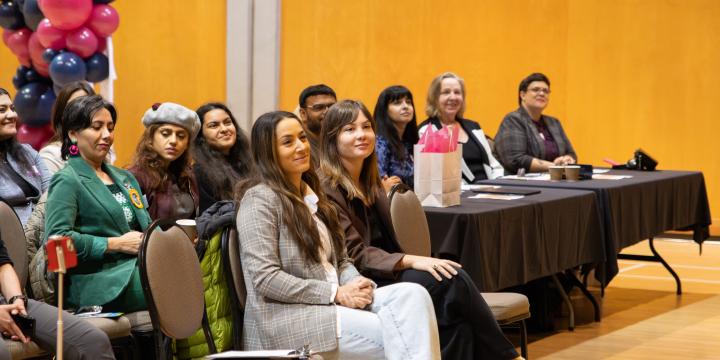
Meet our new YWCA Gear Up Program Manager, Gray Myrfield, who shares starter tips for getting into biking and basic bike maintenance tips below!
Gray had been in the bike industry for over five years, as the Manager at Bike Doctor, when the COVID pandemic encouraged him to make a change.
“Managing the Bike Doctor during the pandemic was certainly an interesting experience. I learned a lot, but that’s a really quick way to burn out on a job,” Gray laughs.

Supply chain issues delayed orders and materials were nearly impossible to get, causing prices to skyrocket. With everyone turning to outdoor activities during the pandemic restrictions, it was difficult to keep up with demand. “The interest was incredibly high. Everyone wanted bikes, but the pipeline just fell apart and every bike went up by about 25%.”
One of the early partners of the YWCA Gear Up, a free bike mechanic training program for youth ages 15 – 30, Bike Doctor has taken on about eight placements out of 10 and continues to be a strong partner.
“I got to see the program from the other side of it.” Bike Doctor took on placements and trained folks interested in learning bike skills or going into the bike industry. “We hired on everyone. We took as many as we could.”
Now four months into his new role as YWCA Gear Up Program Manager, Gray has found the experience “immediately validating.”
Part of what motivates him daily are the interactions with participants. “I got to have some really amazing moments with participants.”
Hearing that Bike Doctor had acquired some used bikes, Gray brokered a deal and bought some of the bikes for the program to be given out via a draw, two per program cycle. The experience gifting the bikes was profound for Gray. “It’s always one thing to know the participants are going through a lot, it’s a very different thing to see the impact you can make. That was the moment I realized I was able to use my skills to do something to make a difference, that had a really big impact on someone’s life.”
YWCA Gear Up is in its 13th cycle, with the next cohort starting on April 8th. Gray is making moves to change the previously hybrid program to fully in-person. “Engagement from in-person was much higher.” He will also be frontloading the number of people during warmer months as less bike shops are willing to take on placements in the fall and winter. Gear Up is also planning to start doing workshops for YWCA employees for cycling safety, and basic bike maintenance!
Bike tips to get you started:
Biking on a budget isn’t easy, but Gray shares the basics to get you started.
“I recommend getting an entry-level bike from a reputable bike shop.” Any bike shop will do, and you can expect to spend about $500-700. “Anything less than that and you start to get into the world of disposable bikes.” If you want it to last or to resell, you need to spend a bit more.
Try before you buy. Take a test ride. “Bike shops love to share their bike knowledge and are usually happy to help fix the bikes they sell. Most bike shops offer a complimentary tune up within the first two months.”
If you are planning on commuting to work, or even if you are riding for leisure, you will need a helmet ($70-$100), lights ($25-$50) and a lock. “I’m extremely passionate about locks. A good rule of thumb is 10% of the value of the bike towards the price of a lock.” Depending on the security of the area you store your bike, a U lock would work for a more secure area. For a more open area, you’ll want a more durable lock.
There are plentiful gadgets and gizmos to add to your biking toolbox if you decide to get more into it, but these tips will start you in good stead for your journey.
Basic bike maintenance:
So you purchased yourself a new bike! That’s fantastic! Let me be the first to welcome you to the cycling community. If you are brand new to bikes and don’t know anything about taking care of a bicycle, that’s okay. Outside of yearly tune ups, there’s only a few things you need to keep an eye on with your new purchase. I’d recommend following these three steps every time before taking a ride.
The first is A for Air. Give your tires a squeeze. They should feel firm and resist your pressure. Pay attention to how a fully pumped-up tire feels for reference. If you are unsure, attach a bike pump to check the pressure. All bike shops I know have a pump available for the public. The pressure your tire should be pumped to will be on the side of the tire itself. While you are checking your tire pressure, if you have a quick release axle, just make sure that it is nice and tight as well. Bike tires naturally leech out air, so it’s normal to have to pump them up a bit every month or two. Riding a bicycle with low tire pressure can feel like you are biking through sand and can result in a pinch flat.
The second is B for Brakes. Squeeze both brake levers and confirm that they are engaging properly. They shouldn’t be able to pull all the way to the grips and they should engage smoothly. You don’t want to learn there is something wrong with your bike’s brakes while you are riding your bike. Get used to giving them a quick check before you get riding. If something isn’t working correctly with your brakes, take the bike into a bike shop.
The third is C for Chain. Chains need to be regularly lubricated to minimize wear. It shouldn’t be dry or squeak. Bike shops will offer both Wet and Dry Lubricant. Wet lube is sticky and doesn’t wash off on the rain, but dust sticks too it. Dry lube flows like water and dust doesn’t stick to it, but washes off easily in the rain. Ask your local bike shop for there recommendation (Use bicycle chain lubricant specifically, DON’T USE WD-40!). To lubricate your chain first either turn your bicycle upside down or have a friend hold up the bicycle by the seat. wipe off any gunk off of the chain with a old rag while pedaling backwards. Give the bottle of lube a shake, then while pedaling backwards again, apply lubricant to the inside of the chain. Wipe off any excess with the rag. Depending on usage, you should be lubricating your chain at least every month.
If you follow these ABC’s, your biking will be safe, and your bike will last you a nice long time. Looking forward to seeing you out there! - Gray Myrfield
YWCA Gear Up is funded by the Government of Canada through the Canada-British Columbia Workforce Development Agreement. The program also receives generous funding from the RBC Foundation. To learn more about YWCA Gear Up, please visit: ywcavan.org/gear-up.

